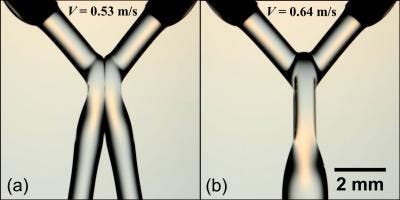When two fluid jets meet, they might coalescence or not depending on a number of factors. The 19th century born John William Strutt, 3rd, also known as Lord Baron Rayleigh made a number of significant contributions to physics during his lifetime, some of his most notable work being in the field of fluids dynamics.
It was Lord Rayleigh who was the first to assert that two fluids will not always merge, a counter intuitive fact that has since then been extensively studied. One side of his empirical observations have never been thoroughly explained, however, until recently until Sunghwan Jung, a Virginia Tech assistant professor of engineering science and mechanics, took it upon himself to write a paper.
“In Rayleigh’s original paper, he mentioned two things: drop bouncing on a liquid bath and jets bouncing. No pictures were given. Much work has been done in drop-bath bouncing, but no work has been done in bouncing jets except for a couple of demonstrations in textbooks. We are the first ones to rationalize the physical mechanism of bouncing jets,” Jung explained.
In his study, Jung and colleagues analyzed two streams of silicon oil that met at a certain point. These were carefully studied and had their velocities incrementally increased until the jets merged.
“Intuition tells us that two or more jets of the same fluid impinging into each other will readily coalesce to form a single mass of fluid, and are well-studied phenomena,” Jung explained.
Apparently, for two jets to coalesce a certain velocity threshold needs to be met. Under this threshold, the two sillicon jets will bounce off each other, since these jets of fluid drag along air, considered to act as a cushion However, when the speed of the flow is increased beyond a certain threshold, the air is no longer stable due to the high inertia of jets, and the liquid jets will coalescence, Jung added.

The issue of non-coalescence is of great interest to scientists since the phenomenon impacts a number of applications, like fuel efficiency, ink jet printing, and the development of spray coatings. Rockets for instance use a mix of fuels which needs to be homogeneous for combustion to occur at maximum parameters.
In our experiments, we showed they are able to bounce off each other and inhibit the mixing. However, in rocket fuel tanks, the fluids come out of the nozzles are a very high speed, so no bouncing happens in their cases,” Jung said.
The findings were detailed in a paper called “Noncoalescence in the oblique collision of fluid jets”, published in the journal Physical Review Letters.






